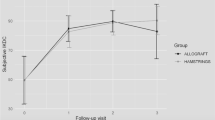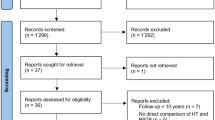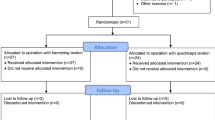Abstract
Purpose
The aim of the present study was to evaluate and compare objective and subjective outcome in patients 2 and 5 years after anterior cruciate ligament (ACL) reconstruction with either bone-patellar tendon-bone (BPTB) or hamstring grafts. The second aim was to report the prevalence of re- and contralateral ACL ruptures.
Methods
Sixty-eight patients (BPTB, n = 34 and hamstring graft, n = 34) were evaluated preoperatively, 2 and 5 years after ACL reconstruction. Anterior knee laxity and rotational knee joint stability, muscle torque, hop length, anterior knee pain, activity level and self-reported knee function and quality of life were evaluated within and between groups. The prevalence of re- and contralateral ACL ruptures was also recorded.
Results
No significant difference in anterior knee laxity, rotational knee joint stability, hop length anterior knee pain or knee function and quality of life were noted at the 5-year follow-up. No significant differences in concentric or eccentric quadriceps torque at 90°/s and 230°/s were found at any of the follow-ups between and within grafts. A significant group difference in hamstring torque 1.05 (0.02) for BPTB and 0.89 (0.02) for hamstring grafts, and in hop length (leg symmetry index) follow-up 0.94 (0.07) for BPTB compared to 0.99 (0.07) for hamstring grafts (P = 0.002) was found at the 2 year follow-up in favour of the BPTB graft, but not at the 5 year follow-up. A significant improvement over time, irrespective of graft, was found in the KOOS′s subscales Sport/Rec and quality of life (P < 0.001). None of the patients, irrespective of group, returned to their pre-injury level of sport (P < 0.05). Over the five postoperative years, one man and eight women (13 %) (hamstring graft, n = 5 and BPTB graft, n = 4), sustained a total of 11 (16.2 %) new ACL ruptures: seven (10.2 %) re-ruptures and four (5.9 %) ruptures of the contralateral ACL.
Conclusions
At the 5-year follow-up, there were no significant differences in terms of anterior knee laxity, rotational knee joint stability, muscle torque, anterior knee pain, hop performance, quality of life or activity level between patients who had undergone reconstruction with BPTB or hamstring grafts. None of the patients, irrespective of group, had returned to their pre-injury level of activity. Eight out of the nine patients who had sustained a second ACL rupture were women.
Level of evidence
II.


Similar content being viewed by others
References
Adams D, Logerstedt D, Giordano-Hunter A, Axe M, Snyder-Mackler L (2012) Current concepts for anterior cruciate ligament reconstruction: a criterion-based rehabilitation progression. JOSPT 42:601–614
Ageberg E, Roos PH, Grävare Silbernagel K, Thomeé R, Roos EM (2009) Knee extension and flexion muscle power after anterior cruciate ligament reconstruction with patellar tendon graft or hamstring tendons graft: a cross-sectional comparison 3 years post surgery. Knee Surg Sports Traumatol Arthrosc 17:162–169
Ahldén M, Samuelsson K, Fu FH, Musahl V, Karlsson J (2013) Rotatory knee laxity. Clin Sports Med 32:37–46
Ardern CL, Taylor NF, Feller JA, Webster KE (2012) Fear of re-injury in people who have returned to sport following anterior cruciate ligament reconstruction surgery. J Sci Med Sports 15:488–495
Ardern CL, Taylor NF, Feller JA, Webster KE (2012) Return-to sport outcomes at 2 to 7 years after anterior cruciate ligament reconstruction surgery. Am J Sports Med 40:41–48
Augustsson J, Thomeé R, Karlsson J (2004) Ability of a new hop test to determine functional deficits after anterior cruciate ligament reconstruction. Knee Surg Sports Traumatol Arthrosc 12:350–356
Barber SD, Noyes FR, Mangine RE, McCloskey JW, Hartman W (1990) Quantitative assessment of functional limitations in normal and anterior cruciate ligament-deficient knees. Clin Orthop Relat Res 255:204–214
Biau DJ, Tournoux C, Katsahian S, Schranz PJ, Nizard RS (2006) Bone-patellar tendon-bone autografts versus hamstring autografts for reconstruction of anterior cruciate ligament: meta-analysis. BMJ 332:995–1001
Farrell M, Richards JG (1986) Analysis of the reliability and validity of the kinetic communicator exercise device. Med Sci Sports Exerc 18:180–185
Feller J, Webster KE (2013) Return to sport following anterior cruciate ligament reconstruction. Int Orthop 37:285–290
Fujita N, Kuroda R, Matsumoto T, Yamaguchi M, Yagi M, Matsumoto A, Kubo S, Matsushita T, Hoshino Y, Nishimoto K, Araki D, Kurosaka M (2011) Comparison of the clinical outcome of double-bundle, anteromedial single-bundle, and posterolateral single-bundle anterior cruciate ligament reconstruction using hamstring tendon graft with minimum 2-year follow-up. Arthroscopy 27:906–913
Gifstad T, Sole A, Strand T, Uppheim G, Grøntvedt T, Drogset JO (2013) Long-term follow-up of patellar tendon grafts or hamstring tendon grafts in endoscopic ACL reconstructions. Knee Surg Sports Traumatol Arhtrosc 21(3):576–583
Hefti F, Müller W, Jakob RP, Staubli HU (1993) Evaluation of knee ligament injuries with the IKDC form. Knee Surg Sports Traumatol Arthrosc 1:226–234
Heijne A, Werner S (2007) Early versus late start of open kinetic chain quadriceps exercises after ACL reconstruction with patellar tendon or hamstring grafts: a prospective randomized outcome study. Knee Surg Sports Traumatol Arthrosc 15:402–414
Heijne A, Werner S (2010) A 2-year follow-up of rehabilitation after ACL reconstruction using patellar tendon or hamstring tendon grafts: a prospective randomised outcome study. Knee Surg Sports Traumatol Arthrosc 18:805–813
Koga H, Nakamae A, Shima Y, Iwasa J, Myklebust G, Engebretsen L, Bahr R, Krosshaug T (2010) Mechanisms for noncontact anterior ligament injuries: knee joint kinematics in 10 injury situations from female handball and basketball. Am J Sports Med 21:271–274
Kvist J, Ek A, Sporrstedt K, Good L (2005) Fear of re-injury: a hindrance for returning to sports after anterior cruciate ligament reconstruction. Knee Surg Sports Traumatol Arthrosc 13:393–397
Lautamies R, Harilainen A, Kettunen J, Sandelin J, Kujala UM (2008) Isokinetic quadriceps and hamstring muscle strength and knee function 5 years after anterior cruciate ligament reconstruction: comparison between bone-patellar tendon-bone and hamstring tendon autografts. Knee Surg Sports Traumatol Arthrosc 16:1009–1016
Laxdal G, Kartus J, Hansson L, Heidvall M, Ejerhed L, Karlsson J (2005) A prospective randomized comparison of bone-patellar tendon-bone and hamstring grafts for anterior cruciate ligament reconstruction. Arthroscopy 21:34–42
Lee DYH, Karim SA, Chang HC (2008) Return to sports after anterior cruciate ligament reconstruction—a review of patients with minimum 5-year follow-up. Ann Acad Med Singapore 37:273–278
Leys T, Salmon L, Waller A, Linklater J, Pinczewski L (2012) Clinical results and risk factors for reinjury 15 years after anterior cruciate ligament reconstruction. A prospective study of hamstrings and patellar tendon grafts. Am J Sports Med 40:595–605
Li S, Chen Y, Lin Z, Cui W, Zhao J, Su W (2012) A systematic review of randomized controlled clinical trials comparing hamstring autografts versus bone-patellar tendon-bone autografts for the reconstruction of the anterior cruciate ligament. Arch Orthop Trauma Surg 132:1287–1297
Little RJ, Raghunathan T (1999) On summary measures analysis of the linear mixed effects model for repeated measures when data are not missing completely at random. Stat Med 18(17–18):2465–2478
Magnussen RA, Carey JL, Spindler KP (2011) Does autograft choice determine intermediate-term outcome of ACL reconstruction. Knee Surg Sports Traumatol Arthrosc 19:462–472
Månsson O, Kartus J, Sernert N (2011) Health-related quality of life after anterior cruciate ligament reconstruction. Knee Surg Sports Traumatol Arthrosc 19:479–487
Mascarenhas R, Tranovich MJ, Kropf EJ, Fu FH, Harner CD (2012) Bone-patellar tendon-bone autograft versus hamstring autograft anterior cruciate ligament reconstruction in the young athlete: a retrospective matched analysis with 2–10 year follow-up. Knee Surg Sports Traumatol Arthrosc 20:1520–1527
Mikkelsen C (2006) Thesis: rehabilitation following bone-patellar tendon-bone graft ACL reconstruction. Karolinska Institutet, Sweden. ISBN 91-7140-913-0
Mohtadi NGH, Chan DS, Dainty KN, Whelan DB (2011) Patellar tendon versus hamstring tendon autograft for anterior cruciate ligament rupture in adults (Review). The Cochrane Libr, 9: CD005960
Roos EM, Roos HP, Ekdahl C, Lohmander LS (1998) Knee injury and osteoarthritis outcome score (KOOS)-validation of a Swedish version. Scand J Med Sci Sports 8:439–448
Roos EM, Roos HP, Lohmander LS, Ekdahl C, Beynnon BD (1998) Knee injury and osteoarthritis outcome score (KOOS)–development of a self-administered outcome measure. J Orthop Sports Phys Ther 28:88–96
Salmon L, Russell V, Musgrove T, Pinczewski L, Refshauge K (2005) Incidence and risk factors for graft rupture and contralateral rupture after anterior cruciate ligament reconstruction. Arthroscopy 21:948–957
Samuelsson K, Daniel Andersson D, Karlsson J (2009) Treatment of anterior cruciate ligament injuries with special reference to graft type and surgical technique: an assessment of randomized controlled trials. Arthroscopy 25:1139–1174
Shelbourne KD, Gray T, Haro M (2009) Incidence of subsequent injury to either knee within 5 years after anterior cruciate ligament reconstruction with patellar tendon autograft. Am J Sports Med 37:246–251
Sutton KL, Bullock JM (2013) Anterior cruciate ligament rupture: differences between males and females. J Am Acad Orthop Surg 21:41–50
Swedish National ACL-register. http://www.artroclinic.se/scripts/cgiip.exe/WService=skreg/xb_index. 01 June 2013
Taylor DC, DeBerardino TM, Nelson BJ, Duffey M, Tenuta J, Stoneman PD, Sturdivant RX, Mountcastle S (2009) Patellar tendon versus hamstring tendon autografts for anterior cruciate ligament reconstruction: a randomized controlled trial using similar femoral and tibial fixation methods. Am J Sports Med 37:1946–1957
Tegner Y, Lysholm J (1985) Rating systems in the evaluation of knee ligament injuries. Clin Orthop Relat Res 198:43–49
Thomeé R, Kaplan Y, Kvist J, Myklebust G, Risberg MA, Theisen D, Tsepis E, Werner S, Wondrasch B, Witvrouw E (2011) Muscle strength and hop performance criteria prior to return to sports after ACL reconstruction. Knee Surg Sports Traumatol Arthrosc 19:1798–1805
Thomeé R, Neeter C, Gustavsson A, Thomeé P, Augustsson J, Eriksson B, Karlsson J (2012) Variability in leg muscle power and hop performance after anterior cruciate ligament reconstruction. Knee Surg Sports Traumatol Arthrosc 20(6):1143–1151
Wipfler B, Donner S, Zechmann CM, Jan Springer J, Siebold R, Paessler HH (2011) Anterior cruciate ligament reconstruction using patellar tendon versus hamstring tendon: a prospective comparative study with 9-year follow-up. Arthroscopy 27:653–665
Wright RW, Magnussen RA, Dunn WR, Spindler KP (2011) Ipsilateral graft and contralateral ACL rupture at five years or more following ACL reconstruction: a systematic review. J Bone Joint Surg Am 93:1159–1165
Wroble RR, Van Ginkel LA, Grood ES, Noyes FR, Shaffer BL (1990) Repeatability of the KT-1000 arthrometer in a normal population. Am J Sports Med 18:396–399
Acknowledgments
We would like to extend our grateful thanks to the patients for sharing their time with us.
Author information
Authors and Affiliations
Corresponding author
Rights and permissions
About this article
Cite this article
Heijne, A., Hagströmer, M. & Werner, S. A two- and five-year follow-up of clinical outcome after ACL reconstruction using BPTB or hamstring tendon grafts: a prospective intervention outcome study. Knee Surg Sports Traumatol Arthrosc 23, 799–807 (2015). https://doi.org/10.1007/s00167-013-2727-1
Received:
Accepted:
Published:
Issue Date:
DOI: https://doi.org/10.1007/s00167-013-2727-1




